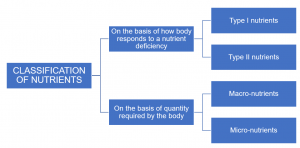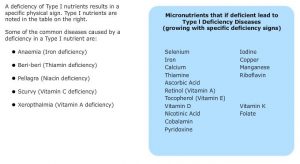
Nutrients can be divided into different types based on the way in which they are classified. There are two major ways in which nutrients can be classified. They are:
- On the basis of how the body responds to a nutrient deficiency
- On the basis of quantity required by the body

Table of Contents
1. On the basis of how body responds to nutrient deficiency:
Based on the way in which the body responds to a nutrient deficiency, nutrients can be classified into two types (Golden, 1995):
a) Type I nutrients and
b) Type II nutrients
Before looking in detail about type I and type II nutrients, we need to know that a body responds to nutrient deficiency in two ways;
- Either by continuing to grow and consuming body stores with eventual reduction in the bodily functions (known as type I nutrient deficiency) OR
- by reducing growth and eagerly conserving the nutrient to maintain the concentration of the nutrient in the tissues (known as type I nutrient deficiency)
Now, let us look in detail about type I and type II nutrients:
a) Type I nutrients:
- Type I nutrients are those nutrients whose deficiency results in specific physical signs.
- This physical sign of deficiency is due to the result of reduced tissue concentration of the nutrient.
- Type I nutrient deficiency results in depletion of body stores which eventually leads to reduction in metabolic functions that are dependent on the nutrient.
- Diagnosis of type I nutrient deficiency is relatively simple and can be done via clinical symptoms and measurement of concentration of nutrients.

- Example: If a diet is deficient in a type I nutrient such as iron, there is an initial consumption of body stores followed by clinical signs characteristic of iron deficiency.
- However, it is necessary to note that deficiency of type I nutrient does not have any effect on growth or body weight.
- Examples of Type I nutrient deficiency are:
- Anemia (iron deficiency),
- Beri-beri (thiamin deficiency),
- Pellagra (niacin or nicotinic acid deficiency),
- Scurvy (vitamin C or ascorbic acid deficiency),
- Xerophthalmia (vitamin A or retinol deficiency)
- Iodine deficiency disorders etc.
b) Type II nutrients:
- Type II nutrients are those nutrients whose deficiency results in reduced growth or weight loss.
- Example: if a diet is deficient in type II nutrient like zinc, growth stops, followed by weight loss. The concentration of zinc in the major tissues remains normal and there are no deficiency signs.
- Type II nutrient deficiency induces preservation of plasma and tissue levels even at the expense of growth, repair and immune system.
- Therefore, it is necessary to note that the deficiency of type II nutrient does not show any physical signs or clinical symptoms and is difficult to identify.
- Moreover, there are no characteristic symptoms to distinguish which type II nutrient deficiency an individual has.
- In Type II nutrient deficiency, growth stops, the body starts to conserve the nutrient, and its excretion falls to very low levels. Additionally, during severe deficiency, the body might break down its own tissues followed by reduction of appetite.

- An animal can die from zinc deficiency even though it has a normal concentration of zinc in its tissues, but it can respond rapidly to small amount of dietary zinc.
- Protein and energy (derived from carbohydrate and fats) are classified as type II nutrients.
- Examples of Type II nutrients whose deficiency in the diet results in growth failure are: protein, zinc, magnesium, phosphorus and potassium.
Importance of Type I and Type II classification:
- This classification reveals that protein-energy malnutrition is not solely responsible for poor growth but it (poor growth) is also the result of other nutrient deficiencies which may not be identified and so appropriately treated.
- This classification exhibits and focuses on the importance of wide variety of nutrients and the need for nutritionally balanced diet.
2. On the basis of quantity required by the body:
Based on the quantity required by the body, nutrients can be divided into two types:
a) Macro-nutrients:
- ‘Macro’ means big.
- Macro nutrients are the nutrients that are required in larger quantity by the body.
- Macro-nutrients include:
- Carbohydrates
- Proteins and
- Macro-nutrients are also called energy providing nutrients.
- They are required in grams.
- Macro-nutrients provide calories and energy.
- It provides bulk energy needed for the metabolic system
Importance of macro-nutrients:
These calories and energy are required for the body to:
- Grow
- Repair and develop new tissues
- Conduct nerve impulses and
- Regulate life processes.
b) Micro-nutrients:
- Micro’ means small.
- Micro nutrients are the nutrients that are required in smaller quantity by the body.
- Micro-nutrients include;
- Vitamins (Vitamin A, B, C, D, E, K)
- Minerals (calcium, potassium, iron, sodium, zinc etc.) and
- Trace elements.
- They are required in micrograms or milligrams.
- Although in small amounts, they are very important and vital for the normal functioning of the body.

Importance of micro-nutrients:
- Enables many chemical reactions to occur in the body.
- Provides support in daily functioning of the body.
- They are important for normal metabolism, growth, development and regulation of cell function.
- Works together with many enzymes and other substances to ensure healthy life.
- It supports in different function of body growth, repair and disease prevention.
References and For More Information:
- https://www.ennonline.net/fex/5/basics
- https://www.ncbi.nlm.nih.gov/pubmed/12346313
- https://www.unicef.org/nutrition/training/
- https://www.tandfonline.com/doi/abs/10.3109/13590849609007256?journalCode=ijne20
- https://mynutrition.wsu.edu/nutrition-basics
- http://www.fao.org/elearning/Course/NFSLBC/en/story_content/external_files/Essential_Nutrients.pdf